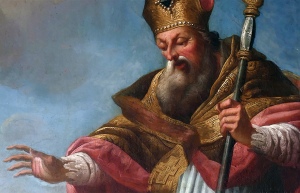The candles haven’t even been lit for Christmas Eve services, but for pastors and church staff looking ahead to the new year, an unusual calendar conflict is waiting in the wings two months from today.
For only the fifth time this century, Ash Wednesday and Valentine’s Day fall on the same day in 2024.
That presents a problem for churches of all kinds. For liturgical churches that observe the first day of the solemn season of Lent, the festive spirit of Valentine’s Day is a stark contrast. Should worshipers get ashes imposed on their foreheads before they go out for a nice dinner with their romantic partners?
Should worshipers get ashes imposed on their foreheads before they go out for a nice dinner with their romantic partners?
And for churches that depend on weekly Wednesday evening programming — choirs, children’s programs, missions groups, Bible studies — there will be difficult decisions about whether to yield to the secular holiday.
This unusual calendar confluence has happened once recently (2018) but before that had not happened since 1923 and 1934 and 1945. It will happen again in 2029 but that’s the last time for this century.
It could be worse, though. In 2018, Easter fell on April Fool’s Day.
You’ve got to laugh
Several pastors contacted by BNG for thoughts on what they’re planning offered tongue-in-cheek responses to this calendar conundrum.
“We’ve been planning this for a while. This year’s ashes will be created by burning roses from last year’s Valentine’s celebration. I’ve also noticed good forehead hearts don’t come off the fingertip easily or consistently. Practice up!” said Jason Edwards, pastor of Second Baptist Church of Liberty, Mo.
Jim Somerville, pastor of First Baptist Church of Richmond, Va., wrote a poem for the occasion:
Will you be my Valentine
For as long as you’re still alive?
Remember that you are dust,
And to dust you shall return.
We’re all going to die.
You. Me. Everybody.
But until then, Dusty:
Will you be mine?
Making a link
While it might seem like a tough task to link Valentine’s Day and Ash Wednesday, Justin Cox has an idea.

Justin Cox
Here’s what he intends to tell his congregation in Connecticut: “I’ve been listening to a fair amount of the Pogues in the wake of proud Irishman and rebellious raconteur Shane McGowen’s death. Listening to his lyrics, I felt a bit of romance there in recognizing the finiteness of self.
“McGowen has this great quote, ‘Cram as much pleasure as you can into life, and rail against the pain that you have to suffer as a result.’ You won’t find a Hallmark card for your partner with that sort of message but share those words after administering the ashes on a loved one’s head, and you have the making of a hell of an Ash Wednesday service.”
He considers this “a call to love with unabandon while you can.” And he’s pretty sure the couple going out for Valentine’s dinner later that evening never will forget it.
Seriously, though
On a more serious note, the unusual confluence of these days illustrates an age-old problem for churches emphasizing religious holidays against secular holidays. This is the same reason so many pastors struggle with Mother’s Day and Father’s Day — often called “Hallmark holidays” even though some churchgoers treat them with religious devotion.
At least Valentine’s Day has some spiritual roots — maybe.
Some historians say Valentine’s Day originated in the Roman festival of Lupercalia, held in mid-February. This festival celebrated the coming of spring and included fertility rites and the pairing of women with men by lottery. (The modern dating and celebration of Christmas also has pagan roots, by the way, most likely.)
Encyclopedia Britannica explains: “At the end of the fifth century, Pope Gelasius I forbid the celebration of Lupercalia and is sometimes attributed with replacing it with St. Valentine’s Day, but the true origin of the holiday is vague at best. Valentine’s Day did not come to be celebrated as a day of romance until about the 14th century.”

Artist’s representation of St. Valentine
The religious story of Valentine’s Day also is contested. Some say the day takes its name from a priest who was martyred about 270 by the emperor Claudius II Gothicus. Legend says that priest signed a letter “from your Valentine” to his jailer’s daughter, whom he had befriended and, perhaps, healed from blindness. Others point to St. Valentine of Terni, a bishop. But these might also be the same person.
The giving of “Valentines” as in cards and gifts, did not appear until the 1500s, and commercially printed cards were not used in the United States until mid-1800s.
Although churches often adapt the message of romantic love to celebrate the model of divine love, the holiday’s roots remain distinctly tied to Roman mythology featuring Cupid, the Roman god of love.
How the wheel of time turns
The reason religious and secular holidays sometimes intermingle is because some holidays are fixed dates and others are moveable. For example, Christians in the Western world celebrate Christmas every year on Dec. 25. But Ash Wednesday is determined by the date of Easter, which the church considers a “moveable feast.”
How the date for Easter is calculated is complicated. It is connected to the date of the Jewish Passover, which is connected to the cycles of the moon. Passover begins on the first full moon after the vernal equinox.
Way back at the First Council of Nicaea, in 325, the Christian church came up with a method of determining Easter based in part on the Passover full moon. Thus, in the Western world, Easter usually falls on the Sunday after the Passover full moon — meaning its date changes significantly from year to year.
How Christmas came to fall on the fixed date of Dec. 25 also is a complicated and contested story. One thing that date has going for it — so far — is lack of competition from other secular festival days that jump around the calendar.


